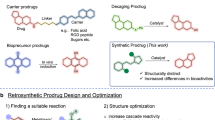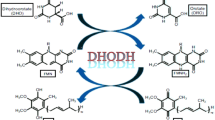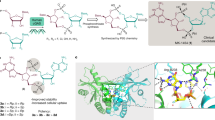Abstract
Over the past century, the use of organ transplantation to replace malfunctioning tissue has leapt from an impossibility to being a routine procedure. This development has hinged on the use of immunosuppressive agents, which prevent rejection of the transplanted tissue. The most potent immunosuppressive drugs employed today are natural products and derivatives thereof, whose discovery, elucidation of mode of action, and introduction into clinical use have been enabled by chemical synthesis. However, more recently, research focusing on immunosuppressive natural products has not been able to identify novel scaffolds for clinical use. Here we discuss examples of immunosuppressive natural products in clinical use, explore how synthesis has contributed to our understanding of the mode of action as well as fundamental biology, and how synthetic chemistry could provide a means for future developments in this area.

This is a preview of subscription content, access via your institution
Access options
Subscribe to this journal
Receive 12 digital issues and online access to articles
$119.00 per year
only $9.92 per issue
Buy this article
- Purchase on Springer Link
- Instant access to full article PDF
Prices may be subject to local taxes which are calculated during checkout






Similar content being viewed by others
References
Delves, P. J. & Roitt, I. M. The immune system. N. Engl. J. Med. 343, 37–49 (2000).
Parkin, J. & Cohen, B. An overview of the immune system. Lancet 357, 1777–1789 (2001).
Chinen, J. & Buckley, R. H. Transplantation immunology: solid organ and bone marrow. J. Allergy Clin. Immunol. 125, S324–S335 (2010).
Marrack, P., Kappler, J. & Kotzin, B. L. Autoimmune disease: why and where it occurs. Nat. Med. 7, 899–905 (2001).
Kahan, B. D. Individuality: the barrier to optimal immunosuppression. Nat. Rev. Immunol. 3, 831–838 (2003).
Elenkov, I. J. Glucocorticoids and the Th1/Th2 balance. Ann. N. Y. Acad. Sci. 1024, 138–146 (2004).
Boumpas, D. T., Chrousos, G. P., Wilder, R. L., Cupps, T. R. & Balow, J. E. Glucocorticoid therapy for immune-mediated diseases: basic and clinical correlates. Ann. Intern. Med. 119, 1198–1208 (1993).
Abbas, A. K., Lichtman, A. H. & Pillai, S. Cellular and Molecular Immunology (Elsevier, 2012).
Kahan, B. D. Forty years of publication of transplantation proceedings—the second decade: the cyclosporine revolution. Transplant. Proc. 41, 1423–1437 (2009).
Borel, J. F., Feurer, C., Gubler, H. U. & Stähelin, H. Biological effects of cyclosporin A: a new antilymphocytic agent. Agents Actions 6, 468–475 (1976).
Kino, T. et al. FK-506, a novel immunosuppressant isolated from a Streptomyces. I. Fermentation, isolation and physico-chemical and biological characteristics. J. Antibiot. 40, 1249–1255 (1987).
Matsuda, S. & Koyasu, S. Mechanism of action of cyclosporin. Immunopharmacology 47, 119–125 (2000).
Wenger, R. M. Synthesis of cyclosporine. Helv. Chim. Acta 67, 502–526 (1984).
Wu, X., Stockdill, J. L., Wang, P. & Danishefsky, S. J. Total synthesis of cyclosporine: access to N-methylated peptides via isonitrile coupling reactions. J. Am. Chem. Soc. 132, 4098–4100 (2010).
Nakatsuka, M. et al. Total synthesis of FK506 and an FKBP probe reagent, (C8,C9-13C2)-FK506. J. Am. Chem. Soc. 112, 5583–5601 (1990).
Jones, T. K. et al. Total synthesis of the immunosuppressant (−)-FK-506. J. Am. Chem. Soc. 111, 1157–1159 (1989).
Ireland, R. E., Gleason, J. L., Gegnas, L. D. & Highsmith, T. K. A total synthesis of FK-506. J. Org. Chem. 61, 6856–6872 (1996).
Schreiber, S. L. The rise of molecular glues. Cell 184, 3–9 (2021).
Vézina, C. & Kudelski, A. Rapamycin (AY-22,989), a new antifungal antibiotic. I. Taxonomy of the producing streptomycete and isolation of the active principle. J. Antibiot. 28, 721–726 (1975).
Sehgal, S. N., Baker, H. & Vézina, C. Rapamycin (Ay-22,989), a new antifungal antibiotic. II. Fermentation, isolation and characterization. J. Antibiot. 28, 727–732 (1975).
Martel, R. R., Klicius, J. & Galet, S. Inhibition of the immune response by rapamycin, a new antifungal antibiotic. Can. J. Physiol. Pharmacol. 55, 48–51 (1977).
Sehgal, S. N., MolnarKimber, K., Ocain, T. D. & Weichman, B. M. Rapamycin: a novel immunosuppressive macrolide. Med. Res. Rev. 14, 1–22 (1994).
Romo, D., Meyer, S. D., Johnson, D. D. & Schreiber, S. L. Total synthesis of (−)-rapamycin using an Evans-Tishchenko fragment coupling. J. Am. Chem. Soc. 115, 7906–7907 (1993).
Meyer, S. D., Miwa, T., Nakatsuka, M. & Schreiber, S. L. Synthetic investigations of rapamycin. 1. Synthesis of a C10-C21 fragment. J. Org. Chem. 57, 5058–5060 (1992).
Romo, D., Johnson, D. D., Plamondon, L., Miwa, T. & Schreiber, S. L. Synthetic investigations of rapamycin. 2. Synthesis of a C22-C42 fragment. J. Org. Chem. 57, 5060–5063 (1992).
Nicolaou, K. C., Chakraborty, T. K., Piscopio, A. D., Minowa, N. & Bertinato, P. Total synthesis of rapamycin. J. Am. Chem. Soc. 115, 4419–4420 (1993).
Hayward, C. M., Yohannes, D. & Danishefsky, S. J. Total synthesis of rapamycin via a novel titanium-mediated aldol macrocyclization reaction. J. Am. Chem. Soc. 115, 9345–9346 (1993).
Smith, A. B. III et al. Total synthesis of rapamycin and demethoxyrapamycin. J. Am. Chem. Soc. 117, 5407–5408 (1995).
Smith, A. B. et al. A unified total synthesis of the immunomodulators (−)-rapamycin and (−)-27-demethoxyrapamycin: assembly of the common C1–20 perimeter and final elaboration. J. Am. Chem. Soc. 119, 962–973 (1997).
Maddess, M. L. et al. Total synthesis of rapamycin. Angew. Chem. Int. Ed. 46, 591–597 (2007).
Ley, S. V. et al. Total synthesis of rapamycin. Chem. A Eur. J. 15, 2874–2914 (2009).
Saridakis, I., Kaiser, D. & Maulide, N. Unconventional macrocyclizations in natural product synthesis. ACS Central Sci. 6, 1869–1889 (2020).
De Lima, C., Julia, M. & Verpeaux, J.-N. Reaction of α-sulfonyl carbanions with electrophilic monohalogenocarbenoids: a new Wittig-like formation of alkenes. Synlett 1992, 133–134 (1992).
Batchelor, M. J., Gillespie, R. J., Golec, J. M. C. & Hedgecock, C. J. R. A novel application of the Dess-Martin reagent to the synthesis of an FK506 analogue and other tricarbonyl compounds. Tetrahedron Lett. 34, 167–170 (1993).
Magnuson, B., Ekim, B. & Fingar, D. C. Regulation and function of ribosomal protein S6 kinase (S6K) within mTOR signalling networks. Biochem. J. 441, 1–21 (2012).
Brown, E. J. et al. A mammalian protein targeted by G1-arresting rapamycin–receptor complex. Nature 369, 756–758 (1994).
Park, S. R., Yoo, Y. J., Ban, Y. H. & Yoon, Y. J. Biosynthesis of rapamycin and its regulation: past achievements and recent progress. J. Antibiot. 63, 434–441 (2010).
Morath, C. et al. Sirolimus in renal transplantation. Nephrol. Dial. Transplant. 22, 61–65 (2007).
Augustine, J. J., Bodziak, K. A. & Hricik, D. E. Use of sirolimus in solid organ transplantation. Drugs 67, 369–391 (2007).
Wali, R. K. & Weir, M. R. Chronic allograft dysfunction: can we use mammalian target of rapamycin inhibitors to replace calcineurin inhibitors to preserve graft function? Curr. Opin. Organ Transplant. 13, 614–621 (2008).
Romo, D. et al. Total synthesis and immunosuppressive activity of (−)-pateamine A and related compounds: implementation of a β-lactam-based macrocyclization. J. Am. Chem. Soc. 120, 12237–12254 (1998).
Rzasa, R. M., Romo, D., Stirling, D. J., Blunt, J. W. & Munro, M. H. G. Structural and synthetic studies of the pateamines: synthesis and absolute configuration of the hydroxydienoate fragment. Tetrahedron Lett. 36, 5307–5310 (1995).
Remuiñán, M. J. & Pattenden, G. Total synthesis of (−)-pateamine, a novel polyene bis-macrolide with immunosuppressive activity from the sponge Mycale sp. Tetrahedron Lett. 41, 7367–7371 (2000).
Zhuo, C.-X. & Fürstner, A. Catalysis-based total syntheses of pateamine A and DMDA-Pat A. J. Am. Chem. Soc. 140, 10514–10523 (2018).
Romo, D. et al. Evidence for separate binding and scaffolding domains in the immunosuppressive and antitumor marine natural product, pateamine A: design, synthesis and activity studies leading to a potent simplified derivative. J. Am. Chem. Soc. 126, 10582–10588 (2004).
Bordeleau, M.-E. et al. Stimulation of mammalian translation initiation factor eIF4A activity by a small molecule inhibitor of eukaryotic translation. Proc. Natl Acad. Sci. USA 102, 10460–10465 (2005).
Bordeleau, M.-E. et al. RNA-mediated sequestration of the RNA helicase eIF4A by pateamine A inhibits translation initiation. Chem. Biol. 13, 1287–1295 (2006).
Low, W.-K. et al. Second-generation derivatives of the eukaryotic translation initiation inhibitor pateamine A targeting eIF4A as potential anticancer agents. Bioorg. Med. Chem. 22, 116–125 (2014).
Pelletier, J., Graff, J., Ruggero, D. & Sonenberg, N. Targeting the eIF4F translation initiation complex: a critical nexus for cancer development. Cancer Res. 75, 250–263 (2015).
Sanglier, J.-J. et al. Sanglifehrins A, B, C and D, novel cyclophilin-binding compounds isolated from Streptomyces sp. A92-308110. I. Taxonomy, fermentation, isolation and biological activity. J. Antibiot. 52, 466–473 (1999).
Fehr, T., Kallen, J., Oberer, L., Sanglier, J. J. & Schilling, W. Sanglifehrins A, B, C and D, novel cyclophilin-binding compounds isolated from Streptomyces sp. A92-308110. II. Structure elucidation, stereochemistry and physico-chemical properties. J. Antibiot. 52, 474–479 (1999).
Zenke, G. et al. Sanglifehrin A, a novel cyclophilin-binding compound showing immunosuppressive activity with a new mechanism of action. J. Immunol. 166, 7165–7171 (2001).
Nicolaou, K. C. et al. Total synthesis of sanglifehrin A. Angew. Chem. Int. Ed. 38, 2447–2451 (1999).
Nicolaou, K. C. et al. Total synthesis of the novel immunosuppressant sanglifehrin A. J. Am. Chem. Soc. 122, 3830–3838 (2000).
Paquette, L. A., Konetzki, I. & Duan, M. Synthesis of the tripeptide (C1–N12) and hydroxylated hexadecene (C26–C41) domains of sanglifehrin A and C. Tetrahedron Lett. 40, 7441–7444 (1999).
Duan, M. & Paquette, L. A. Highly diastereocontrolled synthesis of the C1–C25 domain of sanglifehrin A. Tetrahedron Lett. 41, 3789–3792 (2000).
Paquette, L. A., Duan, M., Konetzki, I. & Kempmann, C. A convergent three-component total synthesis of the powerful immunosuppressant (−)-sanglifehrin A. J. Am. Chem. Soc. 124, 4257–4270 (2002).
Bänteli, R., Brun, I., Hall, P. & Metternich, R. A synthesis of the C1-12 tripeptide fragment of sanglifehrin A. Tetrahedron Lett. 40, 2109–2112 (1999).
Hall, P., Brun, J., Denni, D. & Metternich, R. A stereoselective synthesis of the C13-C19 fragment of sanglifehrin A. Synlett 2000, 315–318 (2000).
Gurjar, M. K. & Chaudhuri, S. R. A stereoselective synthesis of the C13-C19 fragment of sanglifehrin A. Tetrahedron Lett. 43, 2435–2438 (2002).
Chang, C.-F., Flaxman, H. A. & Woo, C. M. Enantioselective synthesis and biological evaluation of sanglifehrin A and B and analogs. Angew. Chem. Int. Ed. 60, 17045–17052 (2021).
Nicolaou, K. C. et al. Total synthesis of epothilone E and related side-chain modified analogues via a Stille coupling based strategy. Bioorg. Med. Chem. 7, 665–697 (1999).
Menche, D., Hassfeld, J., Li, J., Mayer, K. & Rudolph, S. Modular total synthesis of archazolid A and B. J. Org. Chem. 74, 7220–7229 (2009).
Zhang, L. H. & Liu, J. O. Sanglifehrin A, a novel cyclophilin-binding immunosuppressant, inhibits IL-2-dependent T cell proliferation at the G1 phase of the cell cycle. J. Immunol. 166, 5611–5618 (2001).
Zhang, L. H., Youn, H. D. & Liu, J. O. Inhibition of cell cycle progression by the novel cyclophilin ligand sanglifehrin A is mediated through the NFκB-dependent activation of p53. J. Biol. Chem. 276, 43534–43540 (2001).
Steinschulte, C., Taner, T., Thomson, A. W., Bein, G. & Hackstein, H. Cutting edge: sanglifehrin A, a novel cyclophilin-binding immunosuppressant blocks bioactive IL-12 production by human dendritic cells. J. Immunol. 171, 542–546 (2003).
Sedrani, R. et al. Sanglifehrin-cyclophilin interaction: degradation work, synthetic macrocyclic analogues, X-ray crystal structure, and binding data. J. Am. Chem. Soc. 125, 3849–3859 (2003).
Schiene-Fischer, C., Fischer, G. & Braun, M. Non-immunosuppressive cyclophilin inhibitors. Angew. Chem. Int. Ed. 26, e202201597 (2022).
Steadman, V. A. et al. Discovery of potent cyclophilin inhibitors based on the structural simplification of sanglifehrin A. J. Med. Chem. 60, 1000–1017 (2017).
Mackman, R. L. et al. Discovery of a potent and orally bioavailable cyclophilin inhibitor derived from the sanglifehrin macrocycle. J. Med. Chem. 61, 9473–9499 (2018).
Flaxman, H. A. et al. Sanglifehrin A mitigates multi-organ fibrosis in vivo by inducing secretion of the collagen chaperone cyclophilin B. Preprint at https://www.biorxiv.org/content/10.1101/2023.03.09.531890v1 (2023).
Tanaka, N. et al. Clinical acquired resistance to KRASG12C inhibition through a novel KRAS switch-II pocket mutation and polyclonal alterations converging on RAS-MAPK reactivation. Cancer Discov. 11, 1913–1922 (2021).
Fan, Y.-Y. et al. Phainanoids A-F, a new class of potent immunosuppressive triterpenoids with an unprecedented carbon skeleton from Phyllanthus hainanensis. J. Am. Chem. Soc. 137, 138–141 (2015).
Xie, J. et al. Asymmetric total synthesis of (+)-phainanoid A and biological evaluation of the natural product and its synthetic analogues. J. Am. Chem. Soc. 145, 4828–4852 (2023).
Xie, J., Liu, X., Zhang, N., Choi, S. & Dong, G. Bidirectional total synthesis of phainanoid A via strategic use of ketones. J. Am. Chem. Soc. 143, 19311–19316 (2021).
Yan, B.-C. et al. (−)-Isoscopariusin A, a naturally occurring immunosuppressive meroditerpenoid: structure elucidation and scalable chemical synthesis. Angew. Chem. Int. Ed. 60, 12859–12867 (2021).
Fujine, K. et al. FR252921, a novel immunosuppressive agent isolated from Pseudomonas fluorescens: I. Taxonomy, fermentation, isolation, physico-chemical properties and biological activities of FR252921, FR252922 and FR256523. J. Antibiot. 56, 55–61 (2003).
Fujine, K. et al. FR252921, a novel immunosuppressive agent isolated from Pseudomonas fluorescens no. 408813: II. In vitro property and mode of action. J. Antibiot. 56, 62–67 (2003).
Fujine, K. et al. FR252921, a novel immunosuppressive agent isolated from Pseudomonas fluorescens no. 408813. III. In vivo activities. J. Antibiot. 56, 68–71 (2003).
Falck, J. R., He, A., Fukui, H., Tsutsui, H. & Radha, A. Synthesis and stereochemical assignment of FR252921, a promising immunosuppressant. Angew. Chem. Int. Ed. 46, 4527–4529 (2007).
Amans, D., Bellosta, V. & Cossy, J. Synthesis of a promising immunosuppressant: FR252921. Org. Lett. 9, 4761–4764 (2007).
Dethe, D. H., Kumar, V., Beeralingappa, N. C., Mishra, K. B. & Nirpal, A. K. Synthesis of polyene bioactive natural products: FR252921 and vitamin A. Org. Lett. 24, 2203–2207 (2022).
Chen, Y. et al. A domino 10-step total synthesis of FR252921 and its analogues, complex macrocyclic immunosuppressants. J. Am. Chem. Soc. 141, 13772–13777 (2019).
Li, J., Kim, S. G. & Blenis, J. Rapamycin: one drug, many effects. Cell Metab. 19, 373–379 (2014).
Yoo, Y. J., Kim, H., Park, S. R. & Yoon, Y. J. An overview of rapamycin: from discovery to future perspectives. J. Ind. Microbiol. Biotechnol. 44, 537–553 (2017).
Chen, R. et al. Creating novel translation inhibitors to target pro-survival proteins in chronic lymphocytic leukemia. Leukemia 33, 1663–1674 (2019).
Bock, C. et al. High-content CRISPR screening. Nat. Rev. Methods Primers 2, 8 (2022).
Gates, A. J., Gysi, D. M., Kellis, M. & Barabási, A.-L. A wealth of discovery built on the Human Genome Project—by the numbers. Nature 590, 212–215 (2021).
Slatko, B. E., Gardner, A. F. & Ausubel, F. M. Overview of next-generation sequencing technologies. Curr. Protoc. Mol. Biol. 122, e59 (2018).
Hu, T., Chitnis, N., Monos, D. & Dinh, A. Next-generation sequencing technologies: an overview. Hum. Immunol. 82, 801–811 (2021).
Doudna, J. A. & Charpentier, E. Genome editing. The new frontier of genome engineering with CRISPR-Cas9. Science 346, 1258096 (2014).
Shalem, O., Sanjana, N. E. & Zhang, F. High-throughput functional genomics using CRISPR-Cas9. Nat. Rev. Genet. 16, 299–311 (2015).
Deutscher, R. C. E. et al. Discovery of fully synthetic FKBP12-mTOR molecular glues. Preprint at https://chemrxiv.org/engage/chemrxiv/article-details/64be9dddb605c6803b466b52 (2023).
Mayor-Ruiz, C. et al. Rational discovery of molecular glue degraders via scalable chemical profiling. Nat. Chem. Biol. 16, 1199–1207 (2020).
Dubinsky, L., Krom, B. P. & Meijler, M. M. Diazirine based photoaffinity labeling. Bioorg. Med. Chem. 20, 554–570 (2012).
Wright, M. H. & Sieber, S. A. Chemical proteomics approaches for identifying the cellular targets of natural products. Nat. Prod. Rep. 33, 681–708 (2016).
Acknowledgements
Generous support by the ERC (CoG VINCAT 682002 to N.M.), the FWF (Projects P32607 and P35045) and the WWTF (Project LS21-010) is acknowledged. We are grateful to the University of Vienna and the Research Center for Molecular Medicine of the Austrian Academy of Sciences (CeMM) for continued support of our research programmes. We also thank S.S. Strohmenger and L.M. Gail (both CeMM) for fruitful discussions and helpful input.
Author information
Authors and Affiliations
Contributions
M.S., I.S., D.K. and N.M. contributed to discussions and wrote the manuscript.
Corresponding author
Ethics declarations
Competing interests
The authors declare no competing interests.
Peer review
Peer review information
Nature Synthesis thanks the anonymous reviewers for their contribution to the peer review of this work. Primary Handling Editor: Alison Stoddart, in collaboration with the Nature Synthesis team.
Additional information
Publisher’s note Springer Nature remains neutral with regard to jurisdictional claims in published maps and institutional affiliations.
Rights and permissions
Springer Nature or its licensor (e.g. a society or other partner) holds exclusive rights to this article under a publishing agreement with the author(s) or other rightsholder(s); author self-archiving of the accepted manuscript version of this article is solely governed by the terms of such publishing agreement and applicable law.
About this article
Cite this article
Schupp, M., Saridakis, I., Kaiser, D. et al. Chemical synthesis as a discovery platform in immunosuppression and determination of mode of action. Nat. Synth 3, 162–174 (2024). https://doi.org/10.1038/s44160-023-00423-2
Received:
Accepted:
Published:
Issue Date:
DOI: https://doi.org/10.1038/s44160-023-00423-2



